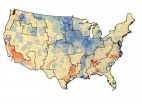Aggressive drug therapy aids superbug evolution
2011-08-04
(Press-News.org) New research raises troubling concerns about the use of aggressive drug therapies to treat a wide range of diseases such as MRSA, C. difficile, malaria, and even cancer.
"The universally accepted strategy of aggressive medication to kill all targeted disease pathogens has the problematic consequence of giving any drug-resistant disease pathogens that are present the greatest possible evolutionary advantage," says Troy Day, one of the paper's co-authors and Canada Research Chair in Mathematical Biology at Queen's.
The researchers note that while the first aim of a drug treatment program should be to make and keep a patient healthy, the patient's immune system also has to be allowed to work.
They suggest several strategies to address the challenge of drug-resistant pathogens including improving the current knowledge base, discovering effective ways for slowing the spread of drug-resistant pathogens from person-to-person, and developing strategies for preventing drug-resistant mutations from occurring in the first place.
Last century's malaria wonder drug, chloroquine, is a perfect example of aggressive medication leading to the growth of drug-resistant pathogens. Since drug-resistant malarial parasites didn't have to compete with parasites that were killed off by an aggressive chloroquine treatment plan, the resistant parasites were given an evolutionary advantage. As a treatment for malaria, chloroquine is now useless across most of Africa.
"As things currently stand, no research exists that can tell us what the optimal drug delivery strategy would be for maintaining treatment effectiveness and mitigating the evolution of resistance," says Dr. Day. "While overwhelming medicinal force may sometimes be required, we need to be clear about when and why this strategy should be chosen since it brings with it some very clear problems with respect to resistance evolution."
INFORMATION:
This research was conducted in collaboration with Andrew Read and Silvie Huijben at Pennsylvania State University and was published in a recent issue of the Proceedings of the National Academy of Sciences.
END
ELSE PRESS RELEASES FROM THIS DATE:
2011-08-04
Measuring the levels of a natural body chemical may allow doctors to reduce the duration of antibiotic use and improve the health outcomes of critically ill patients.
"Infection is a common and expensive complication of critical illness and we're trying to find ways to improve the outcomes of sick, elderly patients and, at the same time, reduce health care costs," says Daren Heyland, a professor of Medicine at Queen's, director of the Clinical Evaluation Research Unit at Kingston General Hospital, and scientific director of the Technology Evaluation in the Elderly Network.
Prolonged ...
2011-08-04
New Rochelle, NY, August 3, 2011—Positive activity interventions (PAIs) offer a safe, low-cost, and self-administered approach to managing depression and may offer hope to individuals with depressive disorders who do not respond or have access to adequate medical therapy, according to a comprehensive review article in The Journal of Alternative and Complementary Medicine, a peer-reviewed journal published by Mary Ann Liebert, Inc. The article, "Delivering Happiness: Translating Positive Psychology Intervention Research for Treating Major and Minor Depressive Disorders" ...
2011-08-04
In the months after the April 16, 2007, shootings at Virginia Tech, two professors administered a survey to assess posttraumatic stress among students. The findings have been published in the July 18, 2011 issue of the Journal of Psychological Trauma: Theory, Research, Practice, and Policy, published by the American Psychological Association.
According to researchers Michael Hughes, professor of sociology in the College of Liberal Arts and Human Sciences, and Russell T. Jones, professor of psychology in the College of Science, 15.4 percent of Virginia Tech students experienced ...
2011-08-04
When we make plans that will change a natural environment — whether it's building a new shopping mall or planting a new forest — surveyors dutifully assess the environmental risks to plant and animal life in the region. But what's environmentally good for one area may be an environmental disaster for an adjacent one, a Tel Aviv University researcher cautions.
When displaced by these projects, indigenous species migrate to neighboring habitats, says Guilad Friedemann, a PhD student at TAU's Department of Zoology in the George S. Wise Faculty of Life Sciences. This has ...
2011-08-04
People spend 3 billion hours a week playing videogames but little is known scientifically about why they are actually fun in the first place.
The vast majority of research into videogames has concentrated on the possible harmful effects of playing videogames, ignoring the simple question of why people actually want to play them.
But new research led by scientists at the University of Essex sheds some light on the appeal of videogames and why millions of people around the world find playing them so much fun.
The study investigated the idea that many people enjoy playing ...
2011-08-04
Many medical devices, ranging from artificial hip joints to dentures and catheters, become sites for unwelcome guests -- complex communities of microbial pathogens called biofilms that are resistant to the human immune system and antibiotics, thus proving a serious threat to human health.
However, researchers may have a new way of looking at biofilms, thanks to a study conducted by University of Iowa biologist David Soll and his colleagues published in the Aug. 2 issue of the online, open access journal PLoS Biology.
Previously, researchers believed that each pathogen ...
2011-08-04
This press release is available in Spanish.
Rising carbon dioxide (CO2) levels can reverse the drying effects of predicted higher temperatures on semi-arid rangelands, according to a study published today in the scientific journal Nature by a team of U.S. Department of Agriculture (USDA) and university scientists.
Warmer temperatures increase water loss to the atmosphere, leading to drier soils. In contrast, higher CO2 levels cause leaf stomatal pores to partly close, lessening the amount of water vapor that escapes and the amount of water plants draw from soil. ...
2011-08-04
JACKSONVILLE, Fla. — A Mayo Clinic orthopedic surgeon suspects that the nagging pain and inflammation that women can experience in their knees may be different from what men encounter, and she has been chosen to lead a novel U.S.-Canadian study to explore the question. The Society for Women's Health Research (SWHR) and its Interdisciplinary Studies in Sex-Differences (ISIS) Network on Musculoskeletal Health has awarded a group of researchers a $127,000 grant to lead a pilot project to understand whether biological differences between men and women affect the incidence and ...
2011-08-04
RICHLAND, Wash. – Today, farming often involves transporting crops long distances so consumers from Maine to California can enjoy Midwest corn, Northwest cherries and other produce when they are out of season locally. But it isn't just the fossil fuel needed to move food that contributes to agriculture's carbon footprint.
New research published in the journal Biogeosciences provides a detailed account of how carbon naturally flows into and out of crops themselves as they grow, are harvested and are then eaten far from where they're grown. The paper shows how regions that ...
2011-08-04
Cambridge, Mass. - August 3, 2011 - Materials scientists and applied physicists collaborating at Harvard's School of Engineering and Applied Sciences (SEAS) have invented a new device that can instantly identify an unknown liquid.
The device, which fits in the palm of a hand and requires no power source, exploits the chemical and optical properties of precisely nanostructured materials to distinguish liquids by their surface tension.
The finding, published in the Journal of the American Chemical Society (JACS), offers a cheap, fast, and portable way to perform quality ...
LAST 30 PRESS RELEASES:
[Press-News.org] Aggressive drug therapy aids superbug evolution




